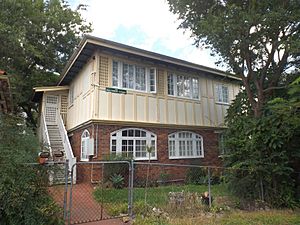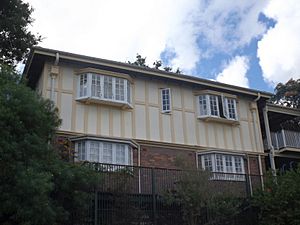Scott Street Flats facts for kids
Quick facts for kids Scott Street Flats |
|
|---|---|

Front entrance, 2015
|
|
| Location | 2 Scott Street, Kangaroo Point, City of Brisbane, Queensland, Australia |
| Design period | 1919 - 1930s (interwar period) |
| Built | c. 1925 |
| Architect | Elina Mottram |
| Architectural style(s) | Tudor |
| Official name: Scott Street Flats, Scott House | |
| Type | state heritage (built) |
| Designated | 29 April 2003 |
| Reference no. | 601171 |
| Significant period | 1920s (fabric) 1920s-1930s (historical) |
| Significant components | laundry / wash house, residential accommodation - flat/s, furniture/fittings |
| Builders | W B Johnstone |
| Lua error in Module:Location_map at line 420: attempt to index field 'wikibase' (a nil value). | |
Scott Street Flats is a special old apartment building located at 2 Scott Street in Kangaroo Point, Brisbane, Australia. It's a "heritage-listed" site, which means it's important to Queensland's history and is protected. This two-story building was designed by Elina Mottram, a pioneering woman architect, and was built around 1925 by W B Johnstone. It is also known as Scott House. The building was added to the Queensland Heritage Register on 29 April 2003.
Contents
A Look Back at Scott Street Flats
The Scott Street Flats were built around 1925. They were made for Professor Frank and Mrs Zina Cumbrae-Stewart. The building was designed by Elina Mottram, one of the first women architects in Queensland. The flats are in Kangaroo Point, a suburb of Brisbane. They are close to the Brisbane River and have views of the city center.
The land where the flats stand was bought by Mrs Zina Cumbrae-Stewart in 1913. The Cumbrae-Stewarts moved to Kangaroo Point around 1914. They lived in a large house next door to where the flats were built. The flats were finished in 1925 and people started living in them around 1926. Later, in 1930, the Cumbrae-Stewarts themselves moved into the flats. They called their home "Scott House."
Why Were the Flats Built?
In the 1920s, Brisbane was growing, and there was a need for more homes. A new law in 1920 also made property taxes higher. This might have encouraged the Cumbrae-Stewarts to build the flats. Many big houses in the city were being turned into apartments. Building flats was a smart idea for Mrs Cumbrae-Stewart. It was an investment, and it also gave her and her husband a convenient home for their later years.
The 1920s saw many new apartment buildings being constructed in Brisbane. The Scott Street Flats are an early example of these purpose-built apartments. They show the popular building styles of the time, like the Old English or Tudor Revival look.
Inside the Flats
These flats were designed with new features for apartment living. They had lots of built-in storage in the kitchen, bathroom, and bedrooms. This made them very space-efficient. The flats were planned so that service areas, like the laundry and maid's room, were separate from the main living areas. The living rooms and bedrooms faced north to get good views of the city and river.
Special features like two-way drawers between the kitchen and dining room helped make life easier. There was also a narrow door from the maid's room to the entry hall. These details helped residents keep their polite lifestyles even in a smaller apartment.
Important People: The Cumbrae-Stewarts
Both Mrs Zina Cumbrae-Stewart and her husband, Frank, were very active and important people in Brisbane.
Frank Cumbrae-Stewart was a lawyer. He became the first registrar and librarian of the new University of Queensland in 1910. He also helped start the Royal Historical Society of Queensland. He was a founder and trustee of the John Oxley Library. He wrote historical papers about the Brisbane River and Brisbane bridges. In 1926, he became a law professor at the University of Queensland.
Mrs Zina Cumbrae-Stewart was just as busy. She was a dedicated member of the Anglican church. She was an executive member of the Australian Red Cross in Queensland for 22 years. She was also president of the Mother's Union and the National Council of Women of Queensland. She helped create the Queensland Social Service League in 1931 to help people during the Great Depression. Mrs Cumbrae-Stewart was the first woman to speak from the stage of the Brisbane City Hall. She was also involved in early educational radio broadcasts.
Important People: Elina Mottram
Elina Mottram was born in 1903. Her father was a building contractor, and he encouraged her to become an architect. In 1924, she became the first woman in Brisbane to open her own architecture business. This was a big achievement!
She was lucky to start her business during a building boom before the Great Depression. At first, she mostly designed homes. But she went on to have a long and varied career. Of the few women who became architects in Queensland before World War II, Elina Mottram was the only one who worked as an architect for her entire career.
Elina Mottram taught building construction at the Brisbane Central Technical College. From 1926, she worked by herself in the town of Longreach. There, she designed houses and public buildings. She also worked with her father in Rockhampton. During World War II, she worked as a draftswoman for the American Army. Later, as an architect for Queensland Railways, she designed the new Eagle Junction railway station. The Scott Street Flats are one of the few remaining examples of her work in Brisbane.
What the Scott Street Flats Look Like
The Scott Street Flats is a two-story building made of timber and brick. It has a Tudor Revival style, which means it looks a bit like old English houses. It has a pyramid-shaped roof with terracotta tiles. The bottom floor is made of red brick. The top floor looks like it has timber frames, but it's actually fibro-cement with timber strips.
The building has simple decorations, like arched brick openings and small timber lattice panels. On the side facing the river, there are four bay windows that stick out.
You enter the flats from the eastern side. Timber stairs lead to an upper porch that is enclosed with timber lattice. A similar area under the stairs leads to the ground floor flat.
Inside, the front door opens into a small entry area. The rooms are laid out carefully. The kitchen and dining room are on one side, and the sitting room and second bedroom are on the other. The main bedroom and bathroom are off the hallway. There's also a service area with back stairs connecting the kitchen, bathroom, and former maid's room.
The floors are timber or linoleum. The walls and ceilings are lined with fibro-cement and timber moldings. The sitting room and dining room have a narrow shelf for plates. Some original light fittings and linoleum are still there. All the rooms have lots of built-in storage. The kitchen has a whole wall of cupboards, drawers, and pantry space. Some drawers can be opened from both the kitchen and the dining room.
The windows are usually multi-paned casement windows. The doors are timber with three panels and original hardware. The bathroom and kitchen have timber ventilation panels. They also have original features like a cast iron, claw foot bath and porcelain enamel sinks. A separate laundry building is in the garden behind the flats. It has concrete sinks and a metal water tank.
Why Scott Street Flats Are Heritage Listed
The Scott Street Flats were added to the Queensland Heritage Register on 29 April 2003 because they are very important for several reasons:
- History of Queensland: The flats show how women started to enter professions like architecture in Queensland. They also show how apartments became popular in Brisbane in the 1920s, changing how people lived in the city.
- Rare and Unique: There are not many other buildings left that were designed by early women architects in Queensland. This makes the Scott Street Flats a rare example of this part of history.
- Beautiful Design: The building is a well-designed example of an early apartment building in the Tudor Revival style. It looks good and shows the architectural trends of its time.
- Connection to Important People: The Scott Street Flats are important because of their connection to Elina Mottram. She was the first woman to open her own architecture business in Brisbane and worked as an architect for a very long time. The flats are also connected to Professor and Mrs Cumbrae-Stewart, who were important citizens in Brisbane during the early 1900s.


